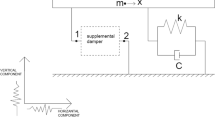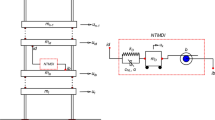Abstract
Adjacent buildings are exposed to a high risk of pounding against each other during seismic events. In recent strong earthquakes events, the separation gap has been found to be insufficient to prevent structural damage related to pounding phenomena. The inerter-based tuned mass damper has been validated as an effective, lightweight passive control device by incorporating the inerter into a conventional tuned mass damper (TMD). The proposed system's optimal design is achieved using a constrained optimization problem based on the Grey Wolf Optimizer (GWO) algorithm. This numerical study investigates the capability of reducing the pounding risk of inertially connected tuned mass dampers (TMDs). The presented system connects two high-rise adjacent buildings as a novel seismic protection system. The optimal design of the proposed system is conducted through a constrained optimization problem via a Grey Wolf Optimizer (GWO) algorithm, wherein the pounding gap distance of the two high-rise adjacent buildings is selected as performance index. Optimal results obtained are critically analyzed and compared. For comparison purposes, two separate TMDs are mounted on the rooftop of each of the adjacent buildings, and the two systems are optimized independently under the constraint of the same total mass. Performance of these independent TMDs is evaluated to compared to that of inertially connected ones using a large number of ground motions selected from a set of 462 ground motion records. The main response parameters of interest are the minimum seismic gap for pounding mitigation, along with inter-storey drift. When the two buildings have different natural frequencies, the results reveal that the suggested new device outperforms the non-connected TMDs system.
Access this chapter
Tax calculation will be finalised at checkout
Purchases are for personal use only
Similar content being viewed by others
References
Bertero, V.V.: Implications of observed pounding of buildings on seismic code regulations. In: 11th World Conference on Earthquake Engineering, Acapulco, Mexico (1996)
Rajaram, C., Ramancharla, P.K.: Calculation of separation distance between adjacent buildings: a review on Codal provisions. J. Seism. Earthq. Eng. 17(1), 31 (2015)
Miari, M., Choong, K.K., Jankowski, R.: Seismic pounding between adjacent buildings: Identification of parameters, soil interaction issues and mitigation measures. Soil Dyn. Earthq. Eng. 121, 135–150 (2019)
Doroudi, R., Lavassani, S.H.H.: Connection of coupled buildings: a state-of-the-art review. Structures (2021). Elsevier
Bertero, V.V.: Observations on structural pounding. In: The Mexico Earthquakes—1985 factors involved and lessons learned (1987). ASCE
Comartin, C.D., Greene, M., Tubbesing, S.K.: The Hyogo-Ken Nanbu earthquake. Earthque Engineering Research Institute (1995)
Kasai, K., Maison, B.F.: Building pounding damage during the 1989 Loma Prieta earthquake. Eng. Struct. 19(3), 195–207 (1997)
Cole, G.L., Dhakal, R.P., Turner, F.M.: Building pounding damage observed in the 2011 Christchurch earthquake. Earthq. Eng. Struct. Dyn. 41(5), 893–913 (2012)
Chouw, N., Hao, H.: Pounding damage to buildings and bridges in the 22 February 2011 Christchurch earthquake. Int. J. Prot. Struct. 3(2), 123–139 (2012)
Raheem, S.E.A.: Mitigation measures for earthquake induced pounding effects on seismic performance of adjacent buildings. Bull. Earthq. Eng. 12(4), 1705–1724 (2014)
Fujii, K., Sakai, Y.: Shaking table test of adjacent building models considering pounding. Seismic Resistant Structures, p. 173 (2018)
Roeslin, S., et al.: The September 19th, 2017 Puebla, Mexico earthquake: final report of the New Zealand reconnaissance team. Bull. N. Z. Soc. Earthq. Eng. 53(3), 150–172 (2020)
Kasai, K., Jagiasi, A.R., Jeng, V.: Inelastic vibration phase theory for seismic pounding mitigation. J. Struct. Eng. 122(10), 1136–1146 (1996)
He, J., et al.: Effectiveness of using polymer bumpers to mitigate earthquake-induced pounding between buildings of unequal heights. Advances in Civil Engineering (2018)
Westermo, B.D.: The dynamics of interstructural connection to prevent pounding. Earthq. Eng. Struct. Dyn. 18(5), 687–699 (1989)
Patel, C., Jangid, R.: Dynamic response of identical adjacent structures connected by viscous damper. Struct. Control Health Monitor. 21(2), 205–224 (2014)
Basili, M., De Angelis, M., Pietrosanti, D.: Dynamic response of a viscously damped two adjacent degree of freedom system linked by inerter subjected to base harmonic excitation. Proc. Eng. 199, 1586–1591 (2017)
Karabork, T., Aydin, E.: Optimum design of viscous dampers to prevent pounding of adjacent structures. Earthq. Struct. 16(4), 437–453 (2019)
Christenson, R.E., et al.: Coupled building control considering the effects of building/connector configuration. J. Struct. Eng. 132(6), 853–863 (2006)
Bharti, S., Dumne, S., Shrimali, M.: Seismic response analysis of adjacent buildings connected with MR dampers. Eng. Struct. 32(8), 2122–2133 (2010)
Bharti, S., Dumne, S., Shrimali, M.: Earthquake response of asymmetric building with MR damper. Earthq. Eng. Eng. Vib. 13(2), 305–316 (2014)
Abdeddaim, M., et al.: Reduction of pounding between buildings using fuzzy controller. Asian J. Civ. Eng. 7(17), 958–1005 (2016)
Abdeddaim, M., et al.: Retrofitting of a weaker building by coupling it to an adjacent stronger building using MR dampers. J. Struct. Eng. Mech. 62(2), 197–208 (2017)
Park, K.-S., Ok, S.-Y.: Coupling ATMD system for seismic response control of two adjacent buildings. Shock Vib. (2019)
Abdeddaim, M., et al.: Seismic retrofitting using the concept of coupling two adjacent buildings. In: Recent Advances in Structural Engineering, vol. 2, pp. 355–363. Springer (2019)
Elias, S.: Seismic energy assessment of buildings with tuned vibration absorbers. Shock Vib. (2018)
Elias, S., Matsagar, V.: Research developments in vibration control of structures using passive tuned mass dampers. Annu. Rev. Control 44, 129–156 (2017)
Elias, S., Matsagar, V.: Distributed multiple tuned mass dampers for wind vibration response control of high-rise building. J. Eng. (2014)
Abdullah, M.M., et al.: Use of a shared tuned mass damper (STMD) to reduce vibration and pounding in adjacent structures. Earthq. Eng. Struct. Dyn. 30(8), 1185–1201 (2001)
Kim, H.-S., Kang, J.-W.: Seismic response control of adjacent buildings using shared tuned mass damper. J. Korean Assoc. Spatial Struct. 14(3), 75–84 (2014)
Kim, H.-S.J.I.J.o.S.S.: Seismic response control of adjacent buildings coupled by semi-active shared TMD. 16(2), 647–656
Guenidi, Z., et al.: Control of adjacent buildings using shared tuned mass damper. Proc. Eng. 199, 1568–1573 (2017)
Rupakhety, R., Elias, S., Olafsson, S.: Shared tuned mass dampers for mitigation of seismic pounding. Appl. Sci. 10(6), 1918 (2020)
Marian, L., Giaralis, A.: Optimal design of a novel tuned mass-damper–inerter (TMDI) passive vibration control configuration for stochastically support-excited structural systems. Probab. Eng. Mech. 38, 156–164 (2014)
Smith, M.C.: Synthesis of mechanical networks: the inerter. In: Proceedings of the 41st IEEE Conference on Decision and Control. IEEE (2002)
Marian, L., Giaralis, A.: The tuned mass-damper-inerter for harmonic vibrations suppression, attached mass reduction, and energy harvesting. Smart Struct. Syst. 19(6), 665–678 (2017)
De Angelis, M., et al.: Optimal tuning and assessment of inertial dampers with grounded inerter for vibration control of seismically excited base-isolated systems. 196, 109250 (2019)
De Domenico, D., Ricciardi, G.: Improving the dynamic performance of base‐isolated structures via tuned mass damper and inerter devices: a comparative study. Struct. Control Health Monit. 25(10), e2234 (2018)
De Domenico, D., Ricciardi, G.: An enhanced base isolation system equipped with optimal tuned mass damper inerter (TMDI). Earthq. Eng. Struct. Dyn. 47(5), 1169–1192 (2018)
Wang, Q., et al.: Seismic response control of adjacent high-rise buildings linked by the Tuned Liquid Column Damper-Inerter (TLCDI). Eng. Struct. 223, 111169 (2020)
De Domenico, D., et al.: Optimal design and seismic performance of Multi‐Tuned Mass Damper Inerter (MTMDI) applied to adjacent high‐rise buildings. Struct. Des. Tall Spec. Build. 29(14), e1781 (2020)
Djerouni, S., et al.: Optimum double mass tuned damper inerter for control of structure subjected to ground motions. J. Build. Eng. 44, 103259 (2021)
Djerouni, S., Elias, S., Abdeddaim, M., Rupakhety, R.: Optimal design and performance assessment of multiple tuned mass damper inerters to mitigate seismic pounding of adjacent buildings. J. Build. Eng. 103994 (2022)
Djerouni, S., Elias, S., Abdeddaim, M., Rupakhety, R.: Optimal design of multiple tuned mass damper inerter applied to adjacent buildings under ground motions. Practice Periodical on Structural Design and Construction (2022)
Chintanapakdee, C.: Evaluation of the modal pushover analysis procedure using vertically “regular” and irregular generic frames. 2002: Report No. UCB/EERC 2003–03, Earthquake Engineering Research Center, University of California, Berkeley, CA
Mirjalili, S., Mirjalili, S.M., Lewis, A.: Grey wolf optimizer. Adv. Eng. Softw. 69, 46–61 (2014)
Kohli, M., Arora, S.: Chaotic grey wolf optimization algorithm for constrained optimization problems. J. Comput. Des. Eng. 5(4), 458–472 (2018)
Teng, Z.-J., Lv, J.-L., Guo, L.-W.: An improved hybrid grey wolf optimization algorithm. Soft. Comput. 23(15), 6617–6631 (2019)
Sahoo, A., Chandra, S.: Multi-objective grey wolf optimizer for improved cervix lesion classification. Appl. Soft Comput. 52, 64–80 (2017)
Kamgar, R., Samea, P., Khatibinia, M.: Optimizing parameters of tuned mass damper subjected to critical earthquake. Struct. Des. Tall Spec. Build. 27(7), e1460 (2018)
Khatibinia, M., Naseralavi, S.S.: Truss optimization on shape and sizing with frequency constraints based on orthogonal multi-gravitational search algorithm. J. Sound Vib. 333(24), 6349–6369 (2014)
Ambraseys, N., et al.: Internet site for European strong-motion data. J Bollettino di geofisica teorica ed applicata 45(3), 113–129 (2004)
Rupakhety, R., Sigbjörnsson, R.: Rotation-invariant measures of earthquake response spectra. Bull. Earthq. Eng. 11(6), 1885–1893 (2013)
Rupakhety, R., Sigbjörnsson, R.: Rotation-invariant mean duration of strong ground motion. J Bull. Earthq. Eng. 12(2), 573–584 (2014)
Ambraseys, N.N., et al.: Dissemination of European strong-motion data, Volume 2. In: Proceedings of the 13th Thirteenth World Conference on Earthquake Engineering, Vancouver, Canada. Paper (2004). Citeseer
Author information
Authors and Affiliations
Corresponding author
Editor information
Editors and Affiliations
Appendix
Appendix
The mass matrix, stiffness and damping matrices for the two buildings (Fig. 9)
Rights and permissions
Copyright information
© 2022 The Author(s), under exclusive license to Springer Nature Switzerland AG
About this chapter
Cite this chapter
Djerouni, S., Abdeddaim, M., Elias, S., De Domenico, D., Rupakhety, R. (2022). Optimal Seismic Response Control of Adjacent Buildings Coupled with a Double Mass Tuned Damper Inerter. In: Bekdaş, G., Nigdeli, S.M. (eds) Optimization of Tuned Mass Dampers. Studies in Systems, Decision and Control, vol 432. Springer, Cham. https://doi.org/10.1007/978-3-030-98343-7_6
Download citation
DOI: https://doi.org/10.1007/978-3-030-98343-7_6
Published:
Publisher Name: Springer, Cham
Print ISBN: 978-3-030-98342-0
Online ISBN: 978-3-030-98343-7
eBook Packages: Intelligent Technologies and RoboticsIntelligent Technologies and Robotics (R0)





